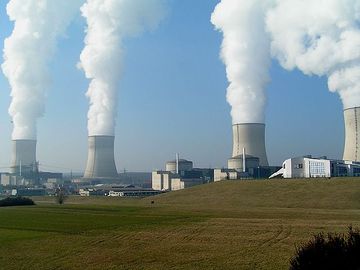Energy from nuclei

Most primary energy ultimately begins with energy from nuclei, often from nuclear fusion in the sun. This nuclear energy is potential energy that is stored inside the nucleus of an atom. This energy holds protons and neutrons in a specific arrangement inside the atomic nucleus.[2] The protons and neutrons inside of the nucleus are held together by the strong nuclear force which balances the repulsion of the Coulomb force between the protons. The weak force balances the number of neutrons and protons. The fact that the strong nuclear force is both stronger and shorter ranged than the Coulomb force is the reason that nuclei are able to stay together up to a specific size. The balance between the strong nuclear force and the Coulomb force is much of what determines whether a nuclide (particular combination of protons and neutrons) will be radioactive or stable.
Nuclear energy is released through three processes: nuclear fission, nuclear fusion, and radioactive decay.[3] Fission occurs when heavy nuclei become unstable and split into smaller parts (usually two main parts and some extra neutrons), fusion happens when light atoms are forced together, and radioactive decay occurs when unstable atoms emit energy and become more stable in the process.[3] Fission can occur spontaneously, but when energy is obtained by humans from fission the process generally occurs after a large isotope has been bombarded by thermal neutrons. Fusion is not yet a viable method for humans to obtain energy from nuclei, but it is the process that occurs in the Sun. There is so much energy involved in nuclear processes (compared to chemical reactions) that a measurable amount of mass is lost, this is called the mass-energy equivalence. When any of these three processes occur, the resulting atoms have less mass than the starting atoms. This mass is converted into a large amount of heat energy, explained by Albert Einstein with his famous equation .[4] There are processes that occur in a lab where energy is turned into mass, but that doesn't happen spontaneously.
The energy from nuclei is considerably more dense than the energy that comes from interacting atoms (which are chemical reactions), about a million times more dense. This is what leads to the incredibly large and destructive power of nuclear weapons that is just not possible with conventional weapons. This energy density also means that there is remarkably little fuel needed to generate electricity. With a million times the energy density, one million times less fuel is needed, and one million times less waste is generated. That waste however still has residual nuclear energy in the from of radioactive decay of fission daughter products.
Electricity Generation
When nuclear energy is used to generate electricity, and this electricity generated through the use of nuclear fission is known as nuclear power. Nuclear bonds that require more energy to break them apart then the energy required to keep them together are the most stable. When less stable nuclei become more stable by releasing particles (nuclear decay), breaking apart (nuclear fission), or joining together (nuclear fusion), energy is released.[2] This energy can be used to heat a liquid or gas to run turbines in a nuclear power plant. By using nuclear energy to heat a liquid or a gas, the energy from nuclear bonds can be harnessed and used to produce electricity. Currently, nuclear energy supplies 6% of the world's primary energy and 14% of its electrical energy (almost half of the electricity that doesn't emit greenhouse gases).[2]
In power plants, nuclear power is harnessed from isotopes of large elements such as uranium, thorium, and plutonium as fuel in nuclear fission reactors. The uranium and thorium isotopes occur naturally and are mined from rock, while plutonium must be created artificially in other reactors. Nuclear fusion in power plants does not yet exist, but fusion has been successfully achieved by humans in laboratories. The big difficulty is getting more energy out of the reaction than went into making it in the first place.
Controversy
The safety, reliability, and cleanliness of nuclear energy are all topics that are fairly controversial. It includes broad topics such as how nuclear waste is dealt with, to investigations of specific nuclear disasters and how nuclear energy is used outside of electricity generation, like for nuclear weapons. There's a strong sense of NIMBY (not in my back yard) for new nuclear power plants. Advocates for nuclear power point to nuclear power as being carbon-free (and generally, emissions free) alternative to fossil fuels that could provide significant amounts of energy worldwide. Critics are generally concerned about health risks of nuclear plants, pointing to nuclear disasters such as Chernobyl and Fukushima as examples of how nuclear plants are unsafe. Please see public acceptance of nuclear power for a more full discussion. Please see public attitudes towards energy sources for historical trends in public opinions on this subject.
References
- ↑ Wikimedia Commons. (July 7, 2015). Nuclear Power Plant [Online]. Available: https://commons.wikimedia.org/wiki/File:Nuclear_Power_Plant_Cattenom.jpg#/media/File:Nuclear_Power_Plant_Cattenom.jpg
- ↑ 2.0 2.1 2.2 R. Wolfson. Energy, Environment and Climate, 2nd ed. New York, U.S.A.: Norton, 2012.
- ↑ 3.0 3.1 C.Ferguson. Nuclear Energy: What Everyone Needs to Know, 1st ed. Cary, NC, USA: Oxford University Press, USA, 2011.
- ↑ Nuclear Energy. (July 7, 2015). What is Nuclear Energy? [Online]. Available: http://nuclear-energy.net/what-is-nuclear-energy

